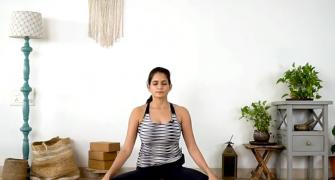Yoga expert Shikha Pandey shows you how simple asanas can help you become fitter this year.
Asanas are a state of being, in which one can remain physically and mentally steady, calm, quiet and comfortable.
Through the practice of asanas, we develop the habit of discipline and the ability to concentrate, both of which are necessary to obtain a steady state of mind.
Here are 5 simple but very effective asanas that can be incorporated in your daily routine to reap specific benefits.
The best time to practice asanas are in the morning empty stomach or at least 3 hours after a meal.
You can also incorporate the following asanas as a warm up or as a cool down to your existing fitness regime.
For maximum benefit, follow the breath pattern highlighted with each asana.
See you on the mat!
Vrikshasana (Tree Pose)
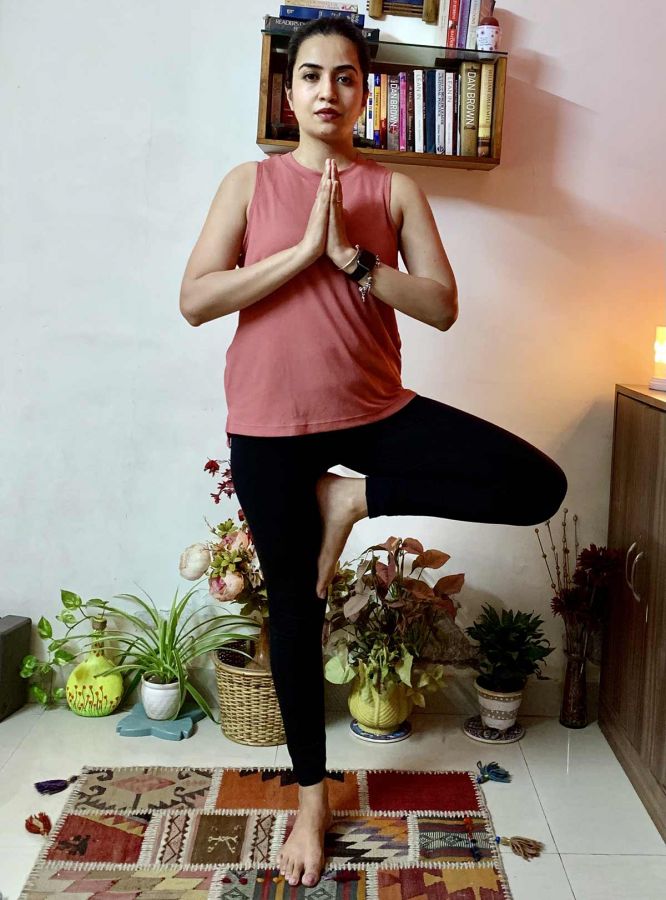
This is a balancing asana that also requires you to practice focus to be able to hold the posture.
This posture is harder than it looks because it calls for complete focus and control on the body. The posture is different every day and that is what keeps it feeling new every time you practice it.
How to do it
- Stand tall lifting up from the crown of your head.
Keep your feet together and feel the weight of your body equally balanced between the ball of the feet and the heels. - With this awareness shift your weight to the right foot and lift your left foot from the ground.
Keep your left leg straight but don't lock the knee. Keep the knee soft. - Bend the left leg and bring the sole of the left foot on the inner right thigh as high as you can take.
If you have sensitive knees or struggle with balance initially, you can also keep the left foot at the right ankle or below the right knee. - Keep in mind to never place the bent foot on the knee. It can be above or below the knee.
- Press the left foot into your right thigh and the right thigh into your left foot with equal pressure so that you are stable and the hips are neutral and the right hip is not jutting out.
- Bring your hands in prayer at the center of your chest. (as you progress you can take your joined hands overheard too)
- Find a point to focus on and fix your gaze to help maintain balance.
- Hold for a count of 5-10 breaths.
- Repeat with the other leg.
- Breathe normally throughout the posture.
Limitations
- People with knee or hip injury should not practice this or should practice the version with foot on opposite ankle after consulting their physician.
Benefits
- Strengthens the legs and core while opening the hips, inner thighs and groin muscles
- Helps build focus
- Helps build balance
- Improves neuromuscular coordination greatly. Neuromuscular stability enhances the response time of the individual. It promotes agility and helps the human mind become more focused.
Paschimottanasana (Seated Forward Fold)
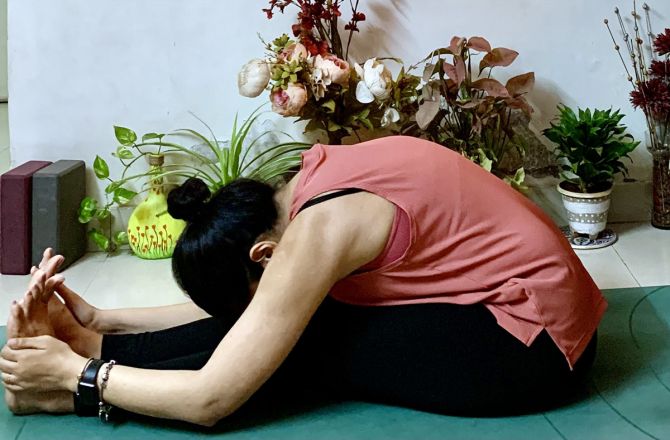
The word paschim meaning west is used in context of the backside of the body and uttan means to stretch. Hence this posture provides a complete stretch to the back of the body from the heels to the cervical.
It's an excellent asana for spinal fitness.
How to do it
- Sit on the mat with legs stretched and toes facing upward.
- Keep the spine erect, shoulders and neck firm and in their place.
- Breathe in and raise your hands over your head and stretch your spine upward.
- Now, while breathing out bring your hands down and bend then forward to touch your legs.
- Place your hands wherever they reach, hold your toes if you can but don't force yourself.
- Breathe in and elongate your spine.
- While breathing out, drop your torso to your legs.
- Every inhale lengthen your spine and every exhale drop a little further.
- When you have reached your limit, relax your elbows and upper body and breathe normally.
- Hold for 5 counts and increase the holding time over time for up to 1-2 minutes.
- Inhaling slowly come back to sitting position with extended legs and spine straight and release the posture.
Limitations
- People suffering from hernia, heart ailments, peptic ulcers, abdominal inflammation, hyper thyroid, serious spinal disorders, myopia & glaucoma should avoid the asana or consult their physician
- Should be avoided during pregnancy.
Benefits
- Posterior stretch of the spine helps in correcting minor deformities of the curvature of the spine.
- Deep abdominal compression massages the abdominal organs and helps relieving conditions related to constipation, weak digestion, sluggish liver.
- Stretches the superficial and deep muscles of the legs, shoulders and back.
- Helps in cases of sciatica and pain in lower back (lumbago).
Manjariasana (Cat and Cow Pose)
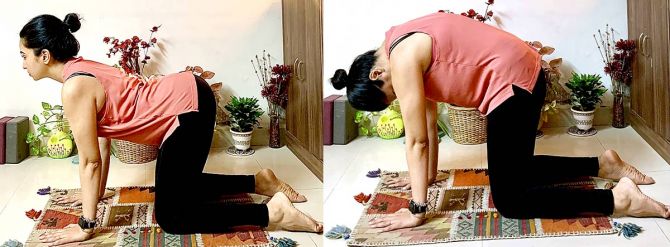
The word manjari means cat and this pose is the cat stretch pose.
Excellent activation of each vertebrae of the spine is achieved through the practice of the posture.
It is ideal to be incorporated in your warm up routine before you dive into your practice or into any other form of fitness activity.
How to do it
- Sit in Vajrasana (Hero's Pose, seated yoga pose)
- Lift your hips and stand on your knees.
- Lean forward and place your hands flat on the floor, right under the shoulders and fingers facing forward.
- The knees will be right above the hips and slightly separated.
- The hands should be in line with the knee.
- The arms and thighs will be perpendicular to the floor.
- From here inhaling raise the head, looking slightly up and dropping the navel to the ground, forming a depression in the spine (The abdomen will be become concave)
- This is starting position
- Expand the abdomen and fill the lungs with maximum amount of air.
- Hold the breath at the top for 3 seconds.
- Exhaling lower the head, tucking the chin to chest. Stretch the spine upward, pushing your shoulders away from the ground.
- At the end of the exhalation, contract the abdomen and pull in the hips.
- Suspend the breath for 3 seconds.
- This is round 1. Perform 5-10 rounds.
- Come back to starting position on completion. Sit in vajrasana and come out of the posture .
Limitations
- People with extreme spinal, abdominal, knee and elbow injury can avoid this posture or consult their physician before practising.
- People with hypertension will not hold or suspend the breath.
Benefits
- Improves the flexibility of the neck, shoulders and spine.
- Tones the female reproductive system and relives of menstural cramps.
- Relieves the tension from the spine and improves blood circulation.
- When done with the right breath pattern, it can be very relaxing and help release tension from the back.
- Excellent for people suffering from desk job fatigue.
Adhomukhshwanasana (Downward Dog)
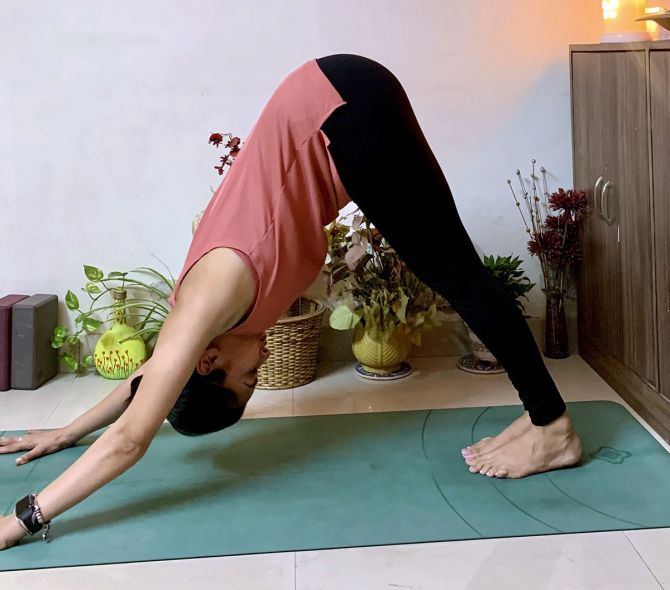
A complete stretch and hence one of the most favourite yoga asanas and much preferred by teachers and students alike. It is an inversion and part of the Surya Namaskar sequence.
How to do it
- Sit in Vajrasana (Hero's Pose)
- Lift your hips and stand on your knees.
- Lean forward and place your hands flat on the floor, a foot or so ahead of your shoulders, fingers facing forward.
- The knees will be right above the hips and slightly separated.
- From here tuck your toes in and lift your hips up towards the sky.
- Lower the head between the arms so that the back and the legs form two sides of a triangle.
- The legs and arms straighten in the final position and the heels draw towards the ground, pushing the head and shoulders towards the knees without straining.
- The hips keep rising towards the sky and shoulders broad (avoid pressing the shoulder blades together)
- Breathe normally in the posture.
- Hold for as long as comfortable and build on the time as you develop strength to hold the posture.
Limitations
- People suffering from heart conditions, high blood pressure, slip disc or severe back concerns should avoid practising this asana.
- Those with illness that makes blood impure should not practice till the blood is purified and the physician gives a nod.
- People with arteriosclerosis, glaucoma, ear infection or any issues in the brain should avoid this posture.
- People with cervical issues should be gentle and should not strain their neck.
Benefits
- The pose strengthens the nerves and muscles in the limbs and back
- Stretch through the Achilles tendons, back of the legs, shoulders and throat region.
- Relaxes the hips.
- It helps in increasing height by stretching muscles and ligaments, enabling growing bones to grow longer. (excellent for kids in growing age).
- Circulation is stimulated in the upper spine between the shoulder blades.
- Good for drawing circulation to the head and face enabling better hair growth and glow on the face.
Bhujangasana (Cobra Pose)
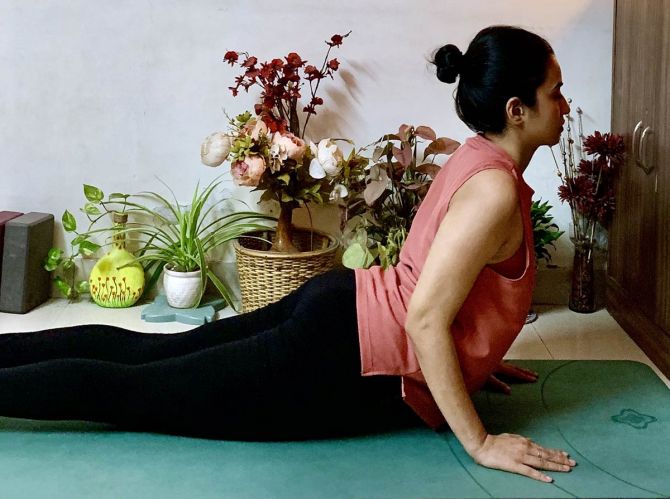
The cobra pose resembles a serpent with its raised hood. It is a reclining back bending asana and a part of the surya namaskar sequence.
How to do it
- Start by lying on your stomach with legs straight, feet together and soles of the feet facing upward.
- Place the palms of the hand flat on the floor, below and slightly to the sides of the shoulder with the fingers together and pointing forward.
- The elbows will be pointing backward and are close to the sides of the body.
- Rest the forehead on the ground.
- Relax the whole body especially the lower back.
- Slowly raise the head inhaling.
- Gently tilt the head backward, the chin points forward , then raise the neck and the shoulders.
- Start straightening the elbows using the back muscles first and then arm muscles to raise the trunk further and arch the back .
- In final position the pubic bones remain in contact with the floor and the navel is only raised very slightly from the ground.
- The arms may or may not be straight depending on the flexibility.
- To come back start bending the arms, elbows still close to the body and lower the navel, chest, shoulders and finally touch forehead to ground.
- Relax the lower back muscles.
Limitations
- People suffering from peptic ulcers, hernia, intestinal tuberculosis, hyperthyroidism should avoid practising this asana.
- People with spinal or abdominal surgery should avoid practising this asana.
Benefits
- Improves and deepens breathing
- It can help to remove back ache and keep the spine supple and healthy.
- Tones the ovaries and uterus and helps regulate mensuration and other gynaecological disorders in women.
- Stimulates appetite, alleviates constipation and is beneficial for all the abdominal organs, especially the liver and kidneys.
- Tones the hips.
- Eases sciatica.

Shikha Pandey is internationally certified in yoga from The Yoga Institute and the founder purnayog.com



